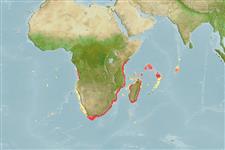Common names from other countries
>
Carangiformes (Jacks) >
Carangidae (Jacks and pompanos) > Caranginae
Etymology: Trachurus: Greek, trachys, -eia, -ys = rough + Greek, oura = tail (Ref. 45335).
Environment: milieu / climate zone / depth range / distribution range
Ekologi
marina bentopelagisk; djupintervall 0 - 400 m (Ref. 3197). Deep-water
Western Indian Ocean: Mozambique and South Africa; also southern Madagascar and Walters Shoals.
Size / Vikt / Age
Maturity: Lm ? range ? - ? cm
Max length : 35.0 cm TL hane/ej könsbestämd; (Ref. 3287)
Taggstrålar i ryggfenan (totalt): 9; Mjukstrålar i ryggfenan (totalt): 28-32; Taggstrålar i analfenan 3; Mjukstrålar i analfenan: 24 - 28. Dark blue above, silvery below; anal and pectoral fins pale yellow; caudal fin dark grey; pelvic fins white or hyaline; opercle with black spot (Ref. 3197).
Adults are found in areas with sandy substrate. They migrate to the surface at night. They feed on fish and small crustaceans (Ref. 5213).
Life cycle and mating behavior
Könsmognad | Reproduktion | Lek | Ägg | Fecundity | Larver
Smith-Vaniz, W.F., 1986. Carangidae. p. 638-661. In M.M. Smith and P.C. Heemstra (eds.) Smiths' sea fishes. Springer-Verlag, Berlin. (Ref. 3197)
IUCN Red List Status (Ref. 130435)
Can't connect to MySQL database (fbapp). Errorcode: Too many connections
